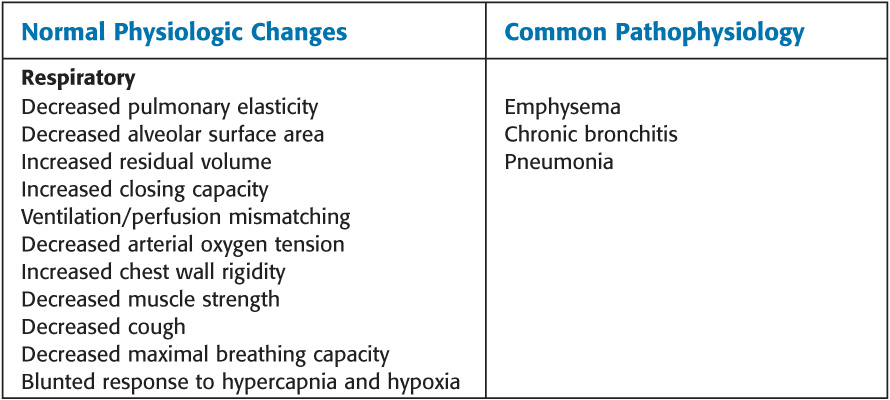Elderly patients have a high incidence of diastolic dysfunction.
Diastolic dysfunction prevents the ventricle from relaxing and consequently creates higher pressures during diastolic ventricular filling, this leading to lower end-diastolic ventricular volumes (preload). Adequate preload is required for generating a normal cardiac output. Patients undergoing surgery may present to the operating room with hypovolemia due to nil per os (NPO) status or emergent situations associated with blood loss; both which decrease preload. Therefore, geriatric patients are at greater risk for low cardiac output, hypotension, decreased oxygen delivery, and ischemia in the setting of both routine and emergent operative procedures.
Clinical manifestations: Marked diastolic dysfunction may occur with systemic hypertension, coronary artery disease; cardiomyopathies; and valvular heart disease, particularly aortic stenosis. Patients may be asymptomatic or complain of exercise intolerance, dyspnea, cough, or fatigue. Diastolic dysfunction results in relatively large increases in ventricular end-diastolic pressure with small changes of left ventricular volume. The atrial contribution to ventricular filling becomes even more important in the setting of diastolic dysfunction. Diminished cardiac reserve in elderly patients may be manifested as exaggerated drops in blood pressure during induction of general anesthesia. A prolonged circulation time delays the onset of intravenous (IV) drugs but speeds induction with inhalational agents. Atrial enlargement predisposes patients to atrial fibrillation and flutter. Patients are at increased risk for developing congestive heart failure.
Diagnosis: Echocardiography provides an assessment of diastolic dysfunction. A ratio of greater than 15 between the peak E velocity of transmitral diastolic filling and the early relaxation velocity on tissue Doppler (E′) is associated with elevated left ventricular end-diastolic pressure and diastolic dysfunction.
Pulmonary
Many changes occur during the aging process that greatly affect the pulmonary system.
• Elasticity is decreased: small airway collapse occurs due to overdistention of the alveoli.
• Residual volume (the volume of air remaining in the lungs at the end of a forced expiration) and closing capacity (CC; the volume of air in the lungs at which small airways begin to close) both increase due to the ease of airway collapse.
• CC may exceed functional residual capacity (FRC; the volume of air remaining in the lungs at the end of a normal expiration) by the age of 45 years in the supine position and age 65 years in the sitting position.
• When CC > FRC, some airways close with expiration during normal tidal breathing, resulting in a mismatch of ventilation and perfusion.
• The arterial oxygen tension decreases by an average rate of 0.35 mm Hg per year.
• Decreased respiratory muscle function or mass and a less compliant chest wall can greatly increase the work of breathing.
Perioperative Issues
• Longer preoxygenation periods are required to prevent hypoxia before induction.
• A higher inspired oxygen concentration is required during anesthesia.
• Aspiration pneumonia is a common and potentially life-threatening complication in elderly patients. Causes of this increase risk include a progressive decrease in protective laryngeal reflexes with age and worse ventilatory impairment in the recovery room.
• Common risks for postoperative pulmonary complications include age older than 64 years, chronic obstructive pulmonary disease, obstructive sleep apnea, malnutrition, and surgical site or type (thoracotomy).
Age-Related Physiologic Changes and Common Diseases of Elderly Adults

Stay updated, free articles. Join our Telegram channel

Full access? Get Clinical Tree





